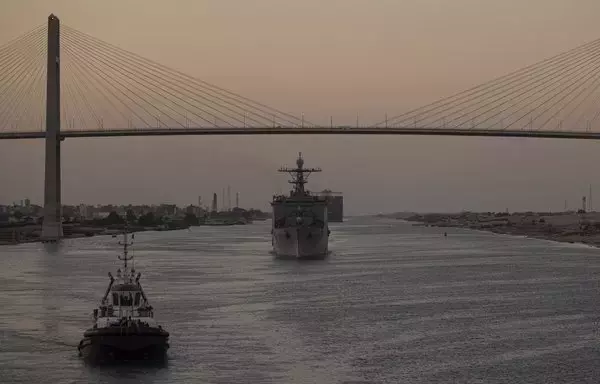The US Navy dock landing ship USS Carter Hall arrived in the Middle East on August 6 along with two other vessels of the 26th Marine Expeditionary Unit (MEU), entering the Red Sea from the Mediterranean through the Suez Canal.
The deployment of the 26th MEU and the accompanying Bataan Amphibious Ready Group comes to support deterrence efforts in the Strait of Hormuz and elsewhere, the US Department of Defense said.
USS Carter Hall is designed to transport and launch landing craft, amphibious vehicles and helicopters, and can transfer cargo to landing craft in rough seas.
It can provide docking and repair service to small ships and craft, and act as the Primary Control Ship (PCS) during amphibious assaults.

![Dock landing ship USS Carter Hall approaches Military Sealift Command fleet replenishment oiler USNS Tippecanoe in this file photo from October 7, 2007. [US Navy]](/ssc/images/2023/08/23/43444-carter-hall-ship-600_384.webp)
USS Carter Hall was commissioned in 1995 and is part of the Harpers Ferry class of dock landing ships, which are modified from the Whidbey Island class vessels to include more cargo and vehicle storage space.
Fully loaded, it will displace more than 16,000 tons, which is roughly the same displacement as an Ohio-class submarine.
With a speed of over 20 knots, it has a normal complement of marines and sailors of about 400, and can surge to 500 if needed.
It can carry two rigid inflatable boats, one V-BAT unmanned aerial system (UAS), six light armored vehicles (LAVs), and up to 26 other wheeled vehicles.
USS Carter Hall has a Phalanx CIWS -- a gun-based close-in weapon system to defend military watercraft against aircraft, missiles and small boats -- mounted forward.
A RAM launcher system, designed to destroy anti-ship missiles, is mounted on top of the ship's bridge.
USS Carter Hall's well deck can hold two air-cushioned landing hovercraft and a variety of landing craft and tracked amphibious assault vehicles.
Its two-spot flight deck can land and service any helicopter in the US Navy and Marine Corps inventory, according to the US military.
The ship's mission is "to transport Marine personnel, landing craft, vehicles and cargo; land them ashore using landing craft and helicopters in support of military and humanitarian assistance operations; and support and withdraw them as necessary," according to the US Navy.
The landing ship dock acts as "an invaluable component to a joint Navy-Marine expeditionary unit, one of which is forward deployed at all times in order to quickly respond to any potential developing crisis," the Navy said.
The USS Carter Hall's motto is "Working for Peace, Ready for War!"
Strengthening Navy's 5th Fleet
More than 3,000 US sailors and marines of the 26th MEU and Bataan Amphibious Ready Group -- accompanying amphibious assault ship USS Bataan -- are taking part in the deployment.
USS Bataan can carry more than two dozen rotary-wing and fixed-wing aircraft, including MV-22 Osprey tilt-rotor aircraft and AV-8B Harrier attack jets in addition to several amphibious landing craft.
These units bring to the region additional aviation and naval assets, and more personnel, providing greater flexibility and maritime capability to US Navy's Bahrain-based 5th Fleet, US Naval Forces Central Command said August 7.
"As we have been for a very long time, we're coordinating with our partners in the region when it comes to US military presence," said Pentagon spokesman Air Force Brig. Gen. Pat Ryder.
"It's not just the US military that's out there patrolling commercial shipping lanes," he stressed. "We're working as part of a broader coalition ... on that effort."
Ryder said the increased US presence in the Middle East is meant to help partners keep open key shipping lanes such as the Strait of Hormuz and contribute to the preservation of security and stability in the region.
"That's why we've deployed these additional assets, to give us additional options, to speed up timelines and, again, broadly, to ensure stability," he said.
The US Navy's 5th Fleet operates across approximately 2.5 million square miles of water space and includes the Arabian Gulf, Gulf of Oman, Red Sea, parts of the Indian Ocean and Strait of Hormuz, Suez Canal and Strait of Bab al-Mandeb.
The 5th Fleet also supports the multinational Combined Maritime Forces, which operate in these waters.
Based in Camp Lejeune, North Carolina, the 26th MEU is designed to conduct amphibious missions, crisis response and limited contingency operations.
These include enabling the introduction of follow-on forces and designated special operations.
Attacks on merchant vessels
Iran has attacked or seized about 20 merchant vessels since 2021.
Last month, the Iranian navy attempted to illegally seize two merchant vessels in the Strait of Hormuz and the Gulf of Oman.
US forces participated in preventing two commercial tanker ships from being seized by the Iranian military in international waters near the coast of Oman, the US military's Central Command said July 5.
Marshall Islands-flagged oil tanker TRF Moss was approached by an Iranian naval vessel, which departed after US Navy guided-missile destroyer USS McFaul arrived.
Later the same day, the Bahamian-flagged oil tanker Richmond Voyager also was approached by an Iranian naval vessel, which fired on it using small arms and crew-served weapons.
The Iranian vessel left when the USS McFaul arrived on the scene.
![USS Bataan and USS Carter Hall sail on the Mediterranean Sea on August 3. They arrived in the Middle East three days later. [US Department of Defense]](/ssc/images/2023/08/23/43440-uss-carter-hall-600_384.webp)





